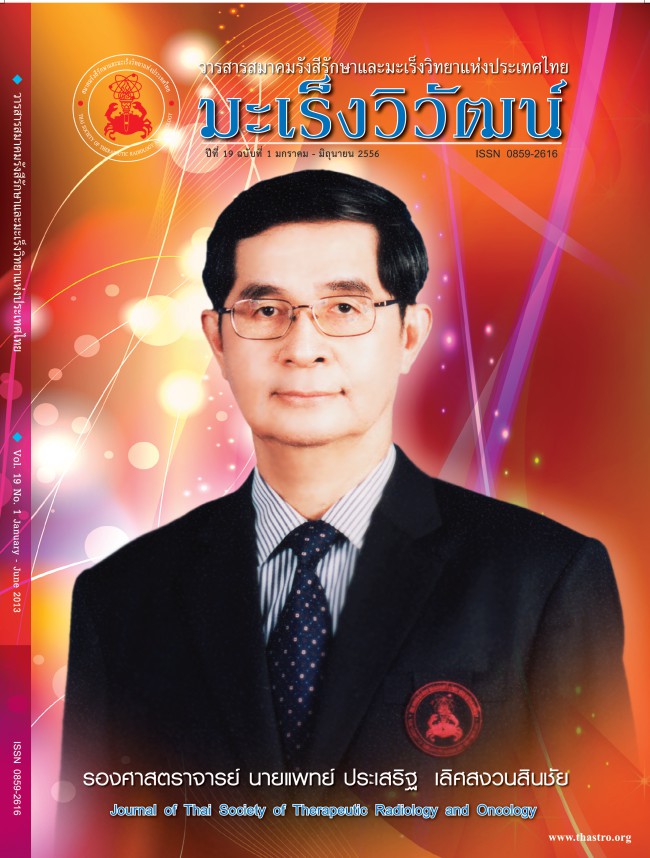High Dose Rate Brachytherapy in the treatment of Uterine Cervical Cancer: Incidence of Late Radiation proctitis and cystitis among different schedules
Abstract
Purpose: This retrospective study at Mahavachiralongkorn hospital aims to explore the survival rate and incidence of radiation proctitis as well as cystitis in patients with uterine cervical cancer treated by high dose rate (HDR) intracavitary brachytherapy (ICRT) and also to compare the late complications among patients receiving different HDR schedules. Methods and materials: A hundred and sixty-eight patients with uterine cervical cancer stage IB-IIIB treated by external beam radiotherapy (EBRT) with a median dose of 5000 cGy followed by Iridium 192 HDR brachytherapy, 500 cGy/F x 5 fractions (57 cases), 600 cGy/F x 4 fractions (59 cases) and 700 cGy/F x 3fractions (52 cases) were enrolled in the study from January 2005 to June 2008. Most patients were assessed by physical examination during the follow-up period. Results: Median age of the patients in this study was 53 years (range of 28-87 years) and median follow-up time was 63 months. Five-year overall survival was 69.0% (95% confidential interval of 64.4%-73.7%). There was no significant difference in survival among the three HDR schedules (500 cGy/F x 5F, 600cGy/F x 4F and 700cGy/F x 3F), 67.0%, 68.0% and 65.0% respectively. The overall late radiation proctitis and cystitis rates were 17.8% and 2.3%, respectively. The incidence of late radiation procitis in 500 cGy/F x5F group was 12.3% which is lower than those in the other two groups, 600 cGy/Fx4F (20.3%)and 700 cGy/Fx3F (21.1%). Majority of the patients with late radiation proctitis presented with grade 1-2, and majority of late radiation cystitis presentation was grade1. There was no severe complication among these patients. Conclusions: In this study, there was no significant difference of 5- years overall survival and incidence of late radiation proctitis and cystitis among three HDR schedules.
References
National Cancer Institute. Cancer in Thailand vol. 5, 2001-2003, Department of Medical Services, Ministry of Public Health, Thailand 2010.
Pathumthani population-base cancer registry 2004-2006, Mahavachiralongkorn Cancer Center, Department of Medical Services, Ministry of Public Health, Thailand 2008.
Horiot JC, Pigneux J, Pourquier H, Schraub S, Achille E, Keiling R, et al. Radiotherapy alone in carcinoma in the intact uterine cervix according to G.H. Fletcher guidelines: A French cooperative study of 1383 cases. Int J Radiation Oncology Biol Phys 1988; 14: 605-11.
Montana G, Fowler W, Varia M, Walton L, Mack Y. Analysis of results of radiation therapy for stage IB carcinoma of uterine cervix. Cancer 1987; 60: 2195-200.
Montana G, Fowler W, Varia M, Walton L, Mack Y. Analysis of results of radiation therapy for stage II carcinoma of uterine cervix. Cancer 1985; 55: 956-62.
Montana G, Fowler W, Varia M, Walton L, Mack Y, Shemanski L. Carcinoma of the cervix, stage III. Cancer 1986; 57: 148-54.
Montana G, Fowler W. Carcinoma of the cervix: Analysis of bladder and rectal radiation dose and complications. Int J Radiation Oncology Biol Phys 1989; 16: 95-100.
Perez CA, Breaux S, Bedwinek JM, Madoc-Jones H, Camel HM, Purdy JA, et al. Radiation therapy alone in the treatment of the uterine cervix: II Analysis of complications. Cancer 1984; 54: 235-46.
Pourquier H, Delard R, Achille E, Daly NJ, Horiot JC, Keiling R, et al. A quantified approach to the analysis and prevention of urinary complications in radiotherapeutic treatment of cancer of the cervix. Int J Radiation Oncology Biol Phys 1987; 13: 1025-33.
Perez CA, Fox S, Lockett MA, Grigsby PW, Camel HM, Galakatos A, et al. Impact of dose in outcome of irradiation alone in carcinoma of the uterine cervix: Analysis of two different methods. Int J Radiation Oncology Biol Phys 1991; 21: 885-98.
Eifel PJ. High-dose-rate brachytherapy for carcinoma of the uterine cervix : High tech or high risk? Int J Radiation Oncology Biol Phys 1992; 24: 383-6.
Nag S, Gupta N. A simple method of obtaining equivalent doses for use in HDR brachytherapy. Int J Radiation Oncology Biol Phys 2000; 46: 507-13.
Dale RG. The application of the linear quadratic dose-effect equation to fractionated and protracted radiotherapy. Br J Radiol 1985; 58: 515-28.
Cox JD, Stetz J, Pajak TF. Toxicity criteria of the Radiation therapy oncology group (RTOG) and the European organization for Research and treatment of canecr (EORTC). Int J Radiation Oncology Biol Phys 1995; 31:1341-6
Pavy JJ, Denekamp J, Letschert J, Littbrand B, Mornex F, Bernier J, et al. Late effects toxicity scoring: THE SOMA SCALE. Int J Radiation Oncology Biol Phys 1995; 31: 1043-7.
บุษณี วิบุลผลประเสริฐ, วรนุช ตั้งเจริญเสถียร. ภาวะแทรกซ้อนของรังสีรักษาในมะเร็งปากมดลูก. รายงานประกอบการศึกษาและฝึกอบรมตามหลักสูตร เพื่อวุฒิบัตรสาขารังสีวิทยาทั่วไป พ.ศ.2527: 1-25
สุพัตรา แสงรุจิ, วิสุทธิ์ วุฒิพฤกษ์, สายสงวน อุณหนันท์. ผลการรักษามะเร็งปากมดลูกชนิด Squamous cell carcinoma ระยะที่ 2 และ ระยะที่ 3 ด้วยเครื่อง Telecobalt และ Selectron LDR ที่โรงพยาบาลศิริราช ระหว่างปี พ.ศ. 2524-2529, วารสารโรคมะเร็ง 2532; 4: 123-9.
Tharavichitkul E, Klunkin P, Lorvidhaya V, Sukthomya V, Chakrabhandu S, Pukanhaphan N, et al. The effect of two HDR brachytherapy schedules in locally advanced cervical cancer treated with concurrent chemoradiation : a study from Chiang Mai, Thailand. J Radiat Res. 2012; 53(2):281-7
Downloads
Published
How to Cite
Issue
Section
License
บทความที่ได้รับการตีพิมพ์เป็นลิขสิทธิ์ของวารสารมะเร็งวิวัฒน์ ข้อความที่ปรากฏในบทความแต่ละเรื่องในวารสารวิชาการเล่มนี้เป็นความคิดเห็นส่วนตัวของผู้เขียนแต่ละท่านไม่เกี่ยวข้องกับ และบุคคลากรท่านอื่น ๆ ใน สมาคมฯ แต่อย่างใด ความรับผิดชอบองค์ประกอบทั้งหมดของบทความแต่ละเรื่องเป็นของผู้เขียนแต่ละท่าน หากมีความผิดพลาดใดๆ ผู้เขียนแต่ละท่านจะรับผิดชอบบทความของตนเองแต่ผู้เดียว




